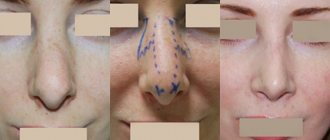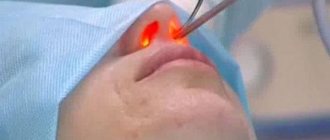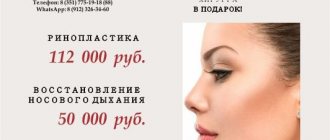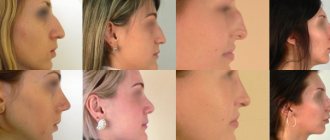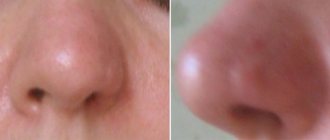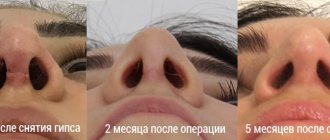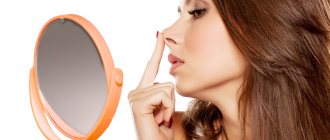Surgery to remove a hump on the nose is a method of correcting the shape of the nose, aimed at solving functional and aesthetic imperfections.
A hump is a formation of osteochondral tissue, which is congenital or acquired (injuries, diseases). During surgery to correct a hump on the nose, the surgeon corrects both types of tissue. Correction of a hump requires highly qualified and experienced rhinosurgeons.
“For some reason, most patients bring photos of Angelina Jolie. Let’s just say I’m not a supporter of “jolinization” of noses. Plus, in my opinion, this is not a standard. For your consultation, it is better to bring 5 photos of noses that you like, from different people (maybe famous, maybe not), from different angles. It will also be great if you find 5 rhinoplasty results that you don’t like. This approach will help us understand each other better.”
Tamarov Alexey Nikolaevich plastic surgeon
Types of rhinoplasty
Nose reduction is one of the most popular procedures. But the method depends on what kind of defect the plastic surgeon will correct. Experts distinguish the following types of operations:
- Base plastic surgery or narrowing of the nose. Allows you to adjust the size of the nostrils, making them neat and attractive. It is performed both for aesthetic reasons and to reduce swelling after other facial surgeries.
- Plastic surgery of the tip of the nose. A labor-intensive procedure that allows you to completely change the visual perception of your face. Rhinoplasty of the tip of the nose eliminates defects such as upturned nose, hooked nose, and asymmetry.
- Columella correction. This is the name given to the skin part of the septum between the nostrils. The procedure is quite simple because it does not require work with cartilage or bony facial structure (unlike hump rhinoplasty, for example).
- Correction of the shape of the nose. During the procedure, the shape of the back changes and the axis is aligned. This is rhinoplasty for a crooked nose.
Nasal septum surgery is a separate category. It is usually carried out for medical reasons and allows you to eliminate breathing problems and reduce the incidence of ENT diseases.
Photos before and after rhinoplasty
Doctor's comments:
Dr. Kharitonov's comments: A typical Caucasian nose is a hump, a wide, overhanging tip of the nose, and excess length of the nose. Closed rhinoplasty was performed, all the listed defects were eliminated, and although only 10 days have passed, swelling and bruising still persist, but the shape of the nose is exactly what the patient wanted.
Closed rhinoplasty of the nose
Plastic surgery on the nose is performed using various techniques, but recently closed rhinoplasty is the most popular. Its advantages:
- Less traumatic;
- Shortened rehabilitation period;
- No scars;
- Maintaining normal tissue nutrition.
Closed rhinoplasty allows you to evaluate the result of the plastic surgeon’s work after 5 months from the date of the procedure. However, the technique is quite complex, and therefore requires experience and skill from a specialist. For nose correction to be successful, it is important to choose a qualified doctor.
FAQ.
1. What time of year is it best to perform the operation?
Rhinoplasty can be done at any time of the year. Weather conditions do not affect the results of correction and the duration of rehabilitation.
2. How many days after rhinoplasty can I go to work?
Most patients return to work within 7-8 days. The maximum period of incapacity for work is 2 weeks.
3. I wear glasses. Will this interfere with recovery after surgery?
The temple of glasses can deform the bridge of the nose. To avoid this, we recommend using contact lenses for the first 4-6 weeks after surgery.
4. When will the nose after rhinoplasty take its final “new” shape?
Tissue healing continues for 4-6 months, so the final results are assessed after this time.
5. Which is better: non-surgical or surgical rhinoplasty? Do you perform injection nose reshaping?
Non-surgical rhinoplasty involves the introduction of special fillers into the soft tissues of the nose. This technique allows you to correct minor defects, but is not able to significantly change the shape of the nose. In addition, it gives a very short-term result - after 6-8 months. The filler is completely absorbed and correction has to be done again. Therefore, in our practice we prefer to use only the surgical technique - as it is more reliable and durable.
Indications and contraindications
Rhinoplasty of the nose can be done if there are visual defects, which include:
- The presence of a hump;
- Saddle shape;
- Hooked tip;
- Excessive length;
- Asymmetrical wings;
- Other aesthetic defects that cause psychological discomfort to the client.
Rhinoplasty of the nose is performed only when the patient reaches the age of 18: until this time, the cartilage continues to grow and form, i.e. plastic surgery on the nose will not give a stable result. Contraindications to the procedure are standard:
- Metabolic disorders (diabetes mellitus);
- Blood diseases;
- Acute infections and exacerbations of chronic diseases;
- Pregnancy and breastfeeding.
Correcting the shape of the nose is possible only after consultation with a surgeon, who measures the main anatomical indicators and compares them with the average statistical data.
In what cases can we definitely help you?
- A long nose
- Wide nasal bridge
- Excessively large or small nose
- Nose axis displacement
- Split tip of the nose
- Hooked, pointed or wide tip
- Saddle nose shape
- Humpback
- Large nostrils
- Asymmetry of the wings of the nose
- Deformation of the nasal septum
- Fractures of the nasal bones
Preparation for the procedure
If you want to have surgery, the first thing you need to do is make an appointment at the clinic for a consultation. Surgeon Vitaly Aleksandrovich Balandin will conduct an examination and determine whether there are indications for nose surgery. Nose surgery begins with a computer simulation of the result: a 3D model allows the client to evaluate how he will look after a wide nose rhinoplasty or nose job.
Regardless of whether the patient is undergoing nasal hump rhinoplasty or nasal septum surgery, the second step is taking tests. If the research does not reveal any contraindications, the date of the operation is set.
Nose correction does not require special preparation. But the surgeon may limit the use of certain medications (for example, vasoconstrictor drops). For rhinoplasty to go well, it is important to provide the specialist with a complete list of medications used.
Where it all begins: how do we prepare patients for rhinoplasty?
Consultation
At your initial appointment, you will meet your rhinoplasty surgeon and discuss all your concerns. The doctor will examine the condition of the tissues, the shape of the nose and ask you to clarify what exactly and how much you want to change. The degree of defects is determined using special measurements, the results of which are compared with the average statistical parameters. Based on your wishes and analysis of facial proportions, the doctor will suggest the optimal correction technique.
Computer modelling
At your request, the surgeon can design the future image on a computer. To do this, he will take several photographs of your face in front and profile, then, using a special program, he will make the expected changes: he will remove excess, straighten unevenness, and correct the contours of the nose.
Making corrections on a computer is much easier than working with living tissue. Therefore, the sketch you see on the screen will most likely differ from the actual result of the operation. However, it will serve as a kind of “guideline” for the doctor. By embodying an imaginary image in a photo, you and the doctor will be sure that you understood each other correctly.
At the end of the appointment, the surgeon will announce the exact cost of the operation and tell you about all the nuances of its implementation.
Survey
After you confirm the decision to undergo rhinoplasty, you will be prescribed a set of necessary diagnostic procedures:
- blood tests for HIV, hepatitis, syphilis
- Blood group and Rh factor tests
- general urine and blood tests
- blood chemistry
- rhinomanometry (study of nasal breathing function)
- ECG
Most of the studies are performed in our clinic and are already included in the price of the correction.
On the eve of the operation, you will sign a formal contract listing all the services that we undertake to provide.
Sign up for a consultation
Carrying out nose surgery
Closed nose reduction is performed under general anesthesia. The scheme is approximately as follows:
- The plastic surgeon makes one or more incisions inside the nostrils to separate the skin from the frame;
- The specialist performs other manipulations: reduces or increases the volume;
- Upon completion of the procedure, the soft tissue is stitched back together.
A bandage is applied to the operated area. Before the procedure, respiratory function is assessed; if it is impaired, rhinoplasty of the nasal septum is performed at the same time.
Nose reshaping takes about an hour, the time varies depending on the individual situation of the patient. The postoperative period is under the strict supervision of the surgeon. You can evaluate the result of rhinoplasty of the nasal wings or other correction after the swelling subsides.
Recovery after correction of the wings of the nose
The rehabilitation period after rhinoplasty as an independent operation is quite quick and easy. On the 5-6th day after surgery to correct the wings of the nose, the surgeon removes the cosmetic sutures.
After rhinoplasty, the patient remains in the hospital at our clinic for at least one day. On the first day, turundas are inserted into the nasal passages, and a plaster splint is placed on top of the nose. The turundas are removed by your doctor the very next day, and the plaster cast is removed after 2 weeks.
Patients often worry about whether scars will remain after rhinoplasty. After 3-4 weeks, the seam will smooth out and will be almost invisible. During the first weeks after rhinoplasty, it is advisable to avoid direct sunlight, not engage in active physical activity, and avoid saunas and steam baths.
How much does rhinoplasty cost?
The price of the procedure depends on the required correction and the individual situation of the client. For example, the cost of rhinoplasty for a snub nose may differ from the removal of a hump or crooked nose. You can find out how much nose surgery costs in the price list below; you can also check the approximate price of the procedure with the clinic administrator by phone. If you want to know exactly how much the operation costs, the cost will be announced by the plastic surgeon after the first consultation.
At the center of aesthetic medicine, appointments are conducted by V.A. Balandin is an experienced plastic surgeon specializing in facial surgery. You can make an appointment online, or by phone. The clinic is open from 9:00 to 22:00, seven days a week.
Non-surgical method for nasal hump removal
Rhinoplasty without surgery is gaining more and more popularity due to its immediate effect without the need for rehabilitation. The filler, injected into the areas near the hump, evens out the contour of the nose by filling it with a gel preparation.
- Advantages of non-surgical hump correction:
- Less traumatic;
- Lack of rehabilitation;
- Comfort and speed;
- Local anesthesia;
- Affordable price.
Trauma can lead to the formation of a hump on the nose. In this case, in addition to aesthetic imperfection, the patient is bothered by difficult or completely absent breathing through the nose. In this case, hump correction is often performed in conjunction with septoplasty.
Consultation before rhinoplasty with surgeon Grishkyan in Moscow
The nose occupies a central position on our face. The presence of even small defects creates disharmony of lines, attracts attention and annoys their owner. Daily dissatisfaction with appearance inevitably forms many complexes, which results in a decrease in self-esteem. From experience we can say that women are more dissatisfied with their appearance. Typically, nose surgery is the most popular among them.
The consultation begins with a comprehensive assessment of the client's facial features. This approach is due to the fact that the plastic surgeon does not simply eliminate the defect, he gives optimal, natural proportions, ideal for each specific case. It is important for us that the end result always pleases.
View all videos
Indications for nose surgery in Moscow at the Doctor Grishkyan clinic:
Modern medicine has advanced technologies that make it possible to perform surgery using the least traumatic method. We have endoscopes, micro-instruments and lasers at our disposal, ensuring a minimally invasive effect, painlessness and a short rehabilitation period.
Go to photo gallery
- hump or saddle shape
- pointed or thickened tip
- disproportionate length
- congenital or due to trauma deformation
- deviated nasal septum
- wide bridge of the nose
- flared nostrils
- labored breathing
Cartilage implants for reconstruction in rhinoplasty
To model and change the shape of the tip of the nose, as well as to strengthen the tip against the possibility of drooping, our own cartilage grafts are used. Cartilage is collected from the nasal septum or ears; as an exception, rib cartilage is used.
There are more than 20 types of cartilage autografts. But we will highlight 3 of them:
- “Rafter” is a narrow rectangular cartilage installed between the medial crura with emphasis on the nasal axis. Its size is not large, 2-2.5 cm in length and only 2-3 mm in width. The “rafters” are strengthened against drooping and, if necessary, the tip of the nose is lengthened and turned. I would like to note that the technology for installing cartilage is such that it is difficult even for a specialist to distinguish an operated nose from a normal one.
- Shield-graft – an implant used on the tip of the nose
- Spreader-graft is a rafter-type autograft installed between the quadrangular cartilage and the septum. Used for reconstruction of the middle section: expansion of the dorsum and volume of the nasal strip, reduction of height, removal of the cartilaginous part of the hump.
Implants at the root of the nose are rarely installed; more often they are necessary to correct an elongated nose and its incorrect position in relation to the face. This position forms the so-called “heavy look.” It is curious that the plasticity of the back does not affect the appearance as much as the placement of cartilage on the root: the features become softer and more welcoming, more open and friendly. Therefore, the problem of a “heavy look” lies in the change not in the eyebrows and forehead, but in the root of the nose.
Modern research proves that using your own cartilage tissue is a very safe procedure. This is an excellent material for aesthetic transformation and restoration of respiratory function.
Computer modeling of rhinoplasty results
The transition to surgery is not carried out without virtual design of the plastic results. The construction of a future model of the nose is not carried out solely according to the wishes of the customer. This equally valuable stage is accompanied by a number of physiological and anatomical studies: external examination, X-ray examination, computed tomography.
Based on the analysis carried out, as well as the client’s wishes, his virtual image with new outlines is formed. It is worth noting that the resulting model provides an estimated, maximally approximate forecast, and not an exact match. The final shapes and sizes obtained after restoration may differ slightly due to the personal characteristics of the body. However, this does not reduce the significance of the procedure. During the design process, the doctor and patient agree on how they want to see the result obtained, and based on this, they select the appropriate method of corrective action.
Here, proper mutual understanding is formed between the customer and the surgeon, risks are specified, which forms the basis for an adequate perception of the results of plastic surgery, warning against excessive demands.
Septoplasty
Deviated nasal septum and its surgical correction during rhinoplasty
Septoplasty is a functionally responsible surgical operation to eliminate a deviated nasal septum and surgical treatment of ENT diseases. It is carried out both independently and in combination with aesthetic correction.
It helps normalize nasal breathing and restore health, which undoubtedly has a positive effect on the quality of life.
Read more about what septoplasty is on our website
